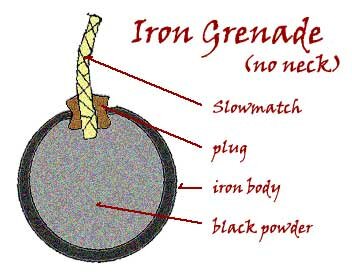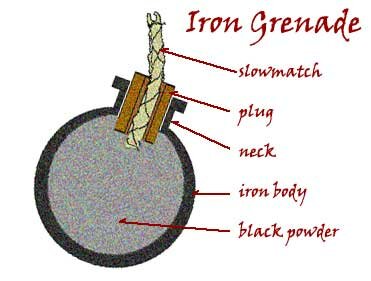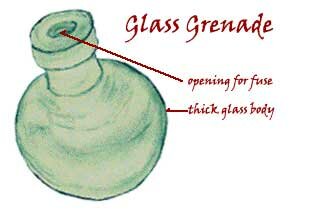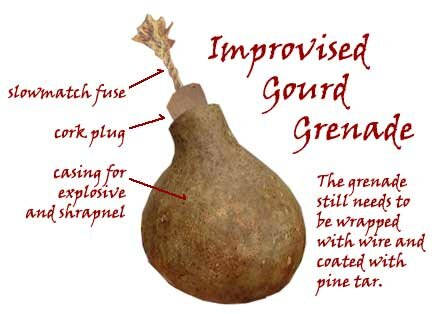Grenades were nothing more that an hollow sphere ranging in size from that of a baseball or girl's softball. There was a hole in the hollow ball which allowed a fuse to inserted. The fuse was a piece of slowmatch that went through the center of a cork or wood plug. The grenade was filled with powder and then the fuse was inserted. The longer the fuse the more time that the grenadier (grenade thrower) had to throw the grenade once the fuse was lit. Grenades were normally made of iron, glass or wood but other materials have also been found (clay, ceramic, tin, brass, etc).
Iron Grenades
Iron grenades were probably the most common. The hollow iron ball would be packed with black powder and plugged with the cork/slowmatch fuse. Upon exploding the iron casing would break apart, throwing bits of iron in all directions.
In confined areas, such as small rooms the concussion of the grenade could also cause serious injury or death even if the shrapnel missed. On occasion some iron grenades had a neck in which the plug was fitted. This allowed a more secure fit for the fuse.


Glass Grenades
Glass grenades were normally made of very thick glass to prevent them from breaking once thrown. Once a glass grenade exploded, the glass would burst with devastating effect. glass grenades had a psychological effect because of the slicing effect of the light weight glass fragments. Most glass grenades had a neck. Unlike the iron grenades, it was more difficult to securely place a fuse in a glass grenade without a neck.

Wood Grenades
While wood grenades were manufactured but their is specualtion that improvised grenades were made from from coconuts or reinforced gourds. The fragments produced by such a grenade was less effective than iron or glass so they were most often supplemented with nails or bits of iron either inserted in the body of the grenade or with the items stuck to the body of the grenade using pine tar or other adhesives. Coconuts would have also been difficult for use as improvised grenade because they were large and often needed to be split in two halves in order to clean out and dry the shell properly. This meant that a weak line existed when the halfs were wired back together and when the bomb exploded the two halfs would split along the natural line and probably not shattered adequately. thus other fragmenting devices would need to be employed. It was also possible that when thrown the coconut or gourd might split on contact, rendering the grenade useless because the black powder will not explode unless it is compacted and confined in the shell.

Improvised Grenade made from a long "dipper" gourd

The only author and editor of all pages on the site. Most of what I write about is based on years of book reading on the topic. My first web page was published back in 1994.